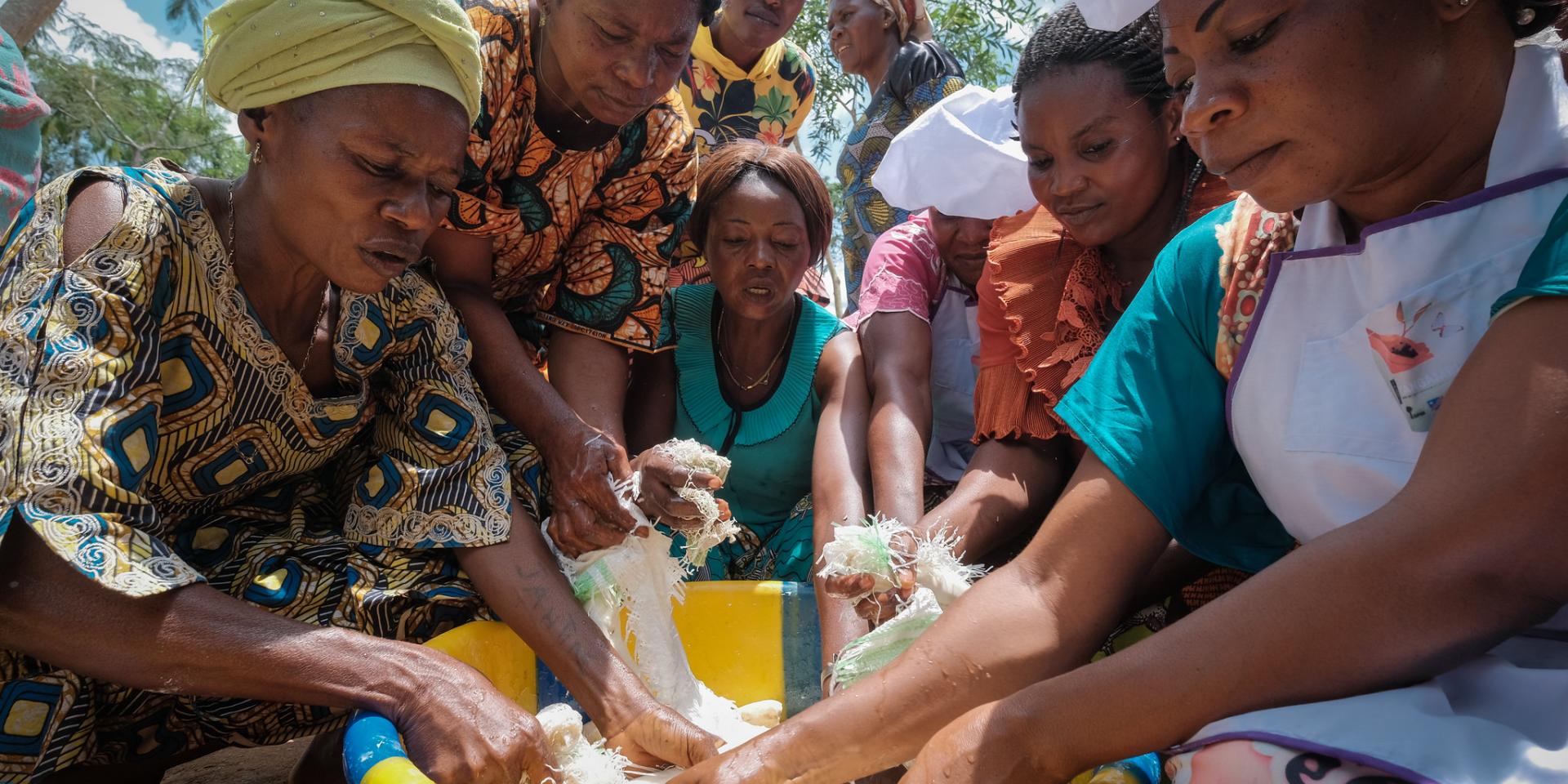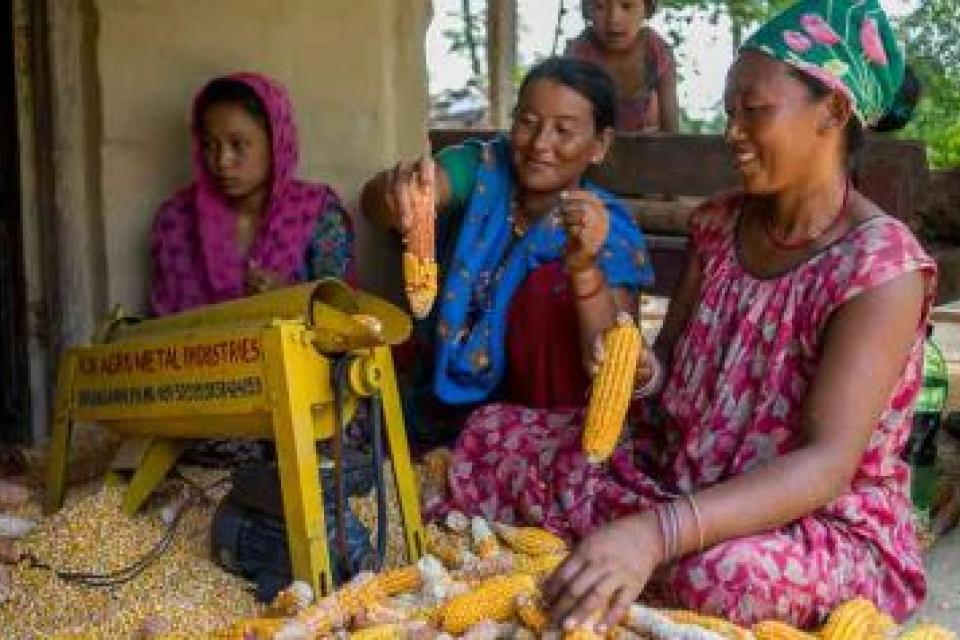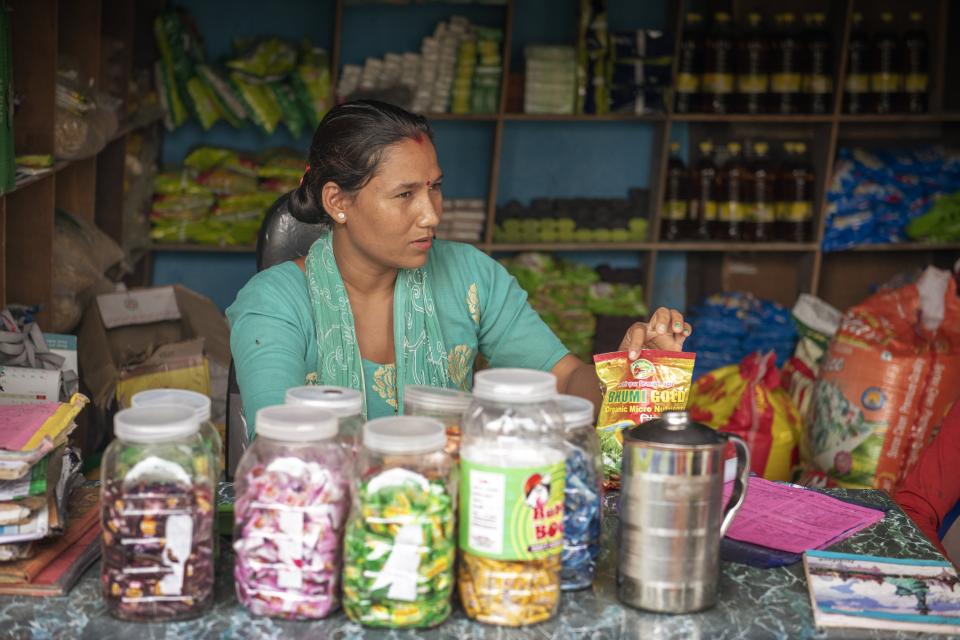Effects of women’s empowerment interventions in food systems
 Photo: Axel Fassio/CIFOR-ICRAF.
Photo: Axel Fassio/CIFOR-ICRAF.
Key messages
- Available evidence indicates that women’s empowerment interventions can improve food security as well as food affordability and/or availability. Effects on diet quality and adequacy are smaller; however, the evidence is limited so this is not conclusive.
- Qualitative evidence suggests that multi-component interventions that combine behavior change with asset transfers are more sustainable than single-focus interventions.
- Gender-transformative approaches that consider gender and social norms and target men to expand women’s social roles may allow women to pursue more livelihoods options outside of the home.
Women are prominent actors within food systems. Nonetheless, relative to men, women face negative and differential access to affordable, nutritious foods. Social norms often place them in a role where they process and prepare food for their households. They are responsible for ensuring food safety, quality and nutrition. Women are stereotyped into provider and maternal roles that often restrict their decision-making abilities on feeding and providing for themselves and their families.
Women’s empowerment interventions, when being gender transformative, represent a key opportunity to improve nutrition-related outcomes. Still, cross-contextual evidence is scant on the factors that cause poorer nutrition outcomes for women and girls and how women’s empowerment can improve nutrition outcomes.
To address this evidence gap, I, along with my colleagues Miriam Berretta, Meital Kupfer and Shannon Shisler, recently conducted a rapid evidence assessment (REA) of 10 studies included in 3ie’s Food Systems and Nutrition Evidence Gap Map (EGM) on women’s empowerment within food systems. The map includes studies identified through a systematic literature search of key academic databases and grey literature sources performed for the regular maintenance of the EGM. Although any intervention that targeted women’s empowerment and functioned within food systems would have been included, all the identified studies were related to agriculture, largely through agricultural asset transfers and educational initiatives.
Overall, women’s empowerment interventions improve nutrition-related outcomes
Women’s empowerment interventions improve food security, food affordability and availability (Table 1). Improvements in diet quality and adequacy, weight relative to height, and well-being were smaller and fewer studies considered these outcomes.
Table 1: Meta-analytical results
| Outcomes | # of included effects (total number of beneficiaries) | Overall effect size [95% CI] | Estimated percentile change compared to control group [95% CI] | Heterogeneity of overall effect (Q and I2) | Range of effects |
|---|---|---|---|---|---|
| Food security | 4 (12,545) | 0.24* [0.00; 0.47] |
9.5% [0; 18.1%] |
111.16***, 97.3% | 0.07 to 0.67 |
| Food affordability and/or availability | 6 (12,972) |
0.23** |
9.1% [3.6%; 14.8%] |
187.27***, 91.99% | -0.11 to 0.49 |
| Diet quality and adequacy | 4 (16,025.5) | 0.09** [0.06, 0.12] |
3.6% [2.4%; 4.8%] |
0.53***, 0% | 0.076 to 0.14 |
| Weight relative to length | 2 (1156.6) | 0.12* [0.00, 0.23] |
4.8% [0; 9.1%] |
0.12, 0% | 0.06 to 0.12 |
| Well-being outcomes | 2 (10,100) | 0.08 [0.01; 0.15] |
3.2% [0.4%; 6%] |
2.9*, 65.6% | -0.11 to 0.04 |
Notes: Overall effect sizes presented are all standardized mean differences.
** indicates a p < 0.01; * p < 0.05
For women’s empowerment interventions to have meaningful impacts, social norms must change, which takes longer periods than current project cycles allow. Impacts theoretically develop through a slow feedback loop in which women’s empowerment increases slightly, giving women more opportunities, leading to more empowerment. Therefore, moderate impacts on ultimate outcomes, like anthropometrics and measures of well-being, may be driven by short evaluation periods.
Community and men’s support, in some cases, facilitated impact. Women in Bangladesh whose husbands were receptive to change were better able to engage in activities outside of the home than those with less receptive husbands. Men’s support may explain the improvements in food security achieved as a result of this program.
Conversely, restrictive social norms prevented women from taking advantage of the interventions in some cases. Asset transfers and educational initiatives were not able to achieve their full, potential impact if women were unable to maintain control over assets or work outside the home. Multi-component interventions which combine asset transfers or educational initiatives with behavior change communication around women’s empowerment, particularly targeting men and community members, may therefore be most impactful.
Although cost evidence was limited, it appears that these interventions are, at least, somewhat cost-effective. Multi-component interventions which combine behavior change with asset transfers may be particularly cost-effective because the additional cost of the behavior change message is likely to be low and result in an amplification of the effect of the asset transfer component.
Although the number of studies identified in this area was limited, we have some confidence in the findings because the quality of the evidence base is generally good. One randomized controlled trial and two quasi-experimental studies have been rated as having a low risk of bias, six randomized controlled trials were rated as having “some concerns” and only one quasi-experimental study has a high risk of bias. The main issues with the six randomized controlled trials are due to reporting bias, performance bias and selection bias, and in quasi-experimental design, to reporting bias, spill-over, cross-over and contamination, performance bias and confounding.
Implications for research and development
There are some gaps in the evidence. For instance, only a few studies were found in South Asia and sub-Saharan Africa, while no studies were found from South America, North Africa or the Middle East. While asset transfer and training were components in almost all studies, behavior change communication components were only used in four studies. More evidence is needed on diet quality and adequacy, mental well-being outcomes and the status of micronutrients.
Future studies should try to avoid outcome measurement bias, reporting bias, spill-over, cross-over and contamination, performance bias, confounding and selection bias. The use of administrative data and anthropometric measures as far as possible can help address performance bias. Authors should explicitly state that outcome measurement is blinded or argue convincingly why self-reported outcomes, which are common in this area, would not be affected by performance bias. To reduce reporting bias, authors can use pre-analysis plans, falsification tests or measure the effect on placebo outcomes. To avoid confounding, randomization and a sufficient set of control variables or other analytical approaches must be used.
Due to the complexity of women’s empowerment interventions, future studies should take into consideration contextual factors that might affect the outcomes, keeping intersectionality in mind. Equity considerations can also be useful to understand how the interventions function. For instance, looking at how the interventions affected women of different castes in India and Bangladesh might have resulted in additional nuances. Mixed method studies and process evaluations can help to better understand why and how an intervention worked or not.
Future research should look at long-term outcomes, such as social norms, that cannot be captured in short-term intervention or evaluation periods, to make sure the data are sufficient and complete. Finally, more cost evidence is needed to know if the impacts were economically efficient.
#
3ie was commissioned to conduct this work by Germany’s Federal Ministry for Economic Cooperation and Development (BMZ) through Deutsche Gesellschaft für Internationale Zusammenarbeit (GIZ) through its “Knowledge for Nutrition” programme.
Suggested citation:
Lane, C. 2022. Effects of women’s empowerment interventions in food systems. CGIAR GENDER Platform Evidence Explainer. Nairobi, Kenya: CGIAR GENDER Platform.
References
Food Systems and Nutrition Evidence Gap Map
Moore, N, Lane, C, Storhaug, I, Franich, A, Rolker, H, Furgeson, J, Sparling, T and Snilstveit, B. 2021. The effects of food systems interventions on food security and nutrition outcomes in low- and middle-income countries, 3ie Evidence Gap Map Report 16. New Delhi: International Initiative for Impact Evaluation (3ie). Available at: https://doi.org/10.23846/EGM016
Food transfers, cash transfers, behavior change communication and child nutrition: Evidence from Bangladesh
Ahmed, Akhter; Hoddinott, John F.; and Roy, Shalini. 2019. Food transfers, cash transfers, behavior change communication and child nutrition: Evidence from Bangladesh. IFPRI Discussion Paper 1868. Washington, DC: International Food Policy Research Institute (IFPRI). https://doi.org/10.2499/p15738coll2.133420
Labor Markets and Poverty in Village Economies
Oriana Bandiera, Robin Burgess, Narayan Das, Selim Gulesci, Imran Rasul, Munshi Sulaiman, Labor Markets and Poverty in Village Economies, The Quarterly Journal of Economics, Volume 132, Issue 2, May 2017, Pages 811–870, https://doi.org/10.1093/qje/qjx003
Home gardening improves dietary diversity, a cluster-randomized controlled trial among Tanzanian women
Blakstad MM, Mosha D, Bellows AL, Canavan CR, Chen JT, Mlalama K, et al. Home gardening improves dietary diversity, a cluster-randomized controlled trial among Tanzanian women. Matern Child Nutr [Internet]. 2021;17(2):e13096. Available from: http://dx.doi.org/10.1111/mcn.13096
Making Cash Crop Value Chains Nutrition-Sensitive: Evidence from a Quasi-Experiment in Rural Sierra Leone
Bonuedi, Isaac and Kornher, Lukas and Gerber, Nicolas, Making Cash Crop Value Chains Nutrition-Sensitive: Evidence from a Quasi-Experiment in Rural Sierra Leone (May 13, 2020). Available at SSRN: https://ssrn.com/abstract=3603918 or http://dx.doi.org/10.2139/ssrn.3603918
Economic and Social Impacts of Self-help Groups in India
Deininger, Klaus; Liu, Yanyan. 2009. Economic and Social Impacts of Self-help Groups in India. Policy Research working paper ; no. WPS 4884. World Bank. © World Bank. https://openknowledge.worldbank.org/handle/10986/4079 License: CC BY 3.0 IGO.
Assessing the Frontiers of Ultra-Poverty Reduction: Evidence from CFPR/TUP, an Innovative Program in Bangladesh
M. Shahe Emran; Stephen Smith and Virginia Robano, (2009), Assessing the Frontiers of Ultra-Poverty Reduction: Evidence from CFPR/TUP, an Innovative Program in Bangladesh, Working Papers, The George Washington University, Institute for International Economic Policy
The large‐scale community‐based programme ‘Suchana’ improved maternal healthcare practices in north‐eastern Bangladesh: Findings from a cluster randomized pre‐post study
Haque MA, Choudhury N, Ahmed SMT, Farzana FD, Ali M, Naz F, Raihan MJ, Rahman SS, Siddiqua TJ, Faruque ASG, Ahmed T. The large-scale community-based programme 'Suchana' improved maternal healthcare practices in north-eastern Bangladesh: Findings from a cluster randomized pre-post study. Matern Child Nutr. 2022 Jan;18(1):e13258. doi: 10.1111/mcn.13258. Epub 2021 Aug 31. PMID: 34467636; PMCID: PMC8710100.
Is women's empowerment a pathway to improving child nutrition outcomes in a nutrition-sensitive agriculture program?: Evidence from a randomized controlled trial in Burkina Faso
Heckert, Jessica; Olney, Deanna K.; and Ruel, Marie T. 2019. Is women's empowerment a pathway to improving child nutrition outcomes in a nutrition-sensitive agriculture program?: Evidence from a randomized controlled trial in Burkina Faso. Social Science and Medicine 233(July 2019): 93-102. https://doi.org/10.1016/j.socscimed.2019.05.016
An Integrated Microcredit, Entrepreneurial Training, and Nutrition Education Intervention Is Associated with Better Growth Among Preschool-Aged Children in Rural Ghana
Grace S Marquis, Esi K Colecraft, Owuraku Sakyi-Dawson, Anna Lartey, Ben K Ahunu, Katherine A Birks, Lorna M Butler, Manju B Reddy, Helen H Jensen, Elizabeth Huff-Lonergan, An Integrated Microcredit, Entrepreneurial Training, and Nutrition Education Intervention Is Associated with Better Growth Among Preschool-Aged Children in Rural Ghana, The Journal of Nutrition, Volume 145, Issue 2, February 2015, Pages 335–343, https://doi.org/10.3945/jn.114.194498
Agricultural Extension and Technology Adoption for Food Security: Evidence from Uganda
Pan Y, Smith SC, Sulaiman M. Agricultural extension and technology adoption for food security: Evidence from Uganda. Am J Agric Econ [Internet]. 2018;100(4):1012–31. Available from: http://dx.doi.org/10.1093/ajae/aay012


